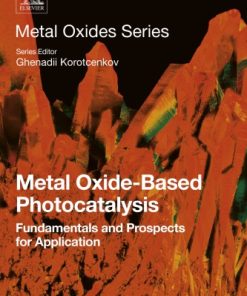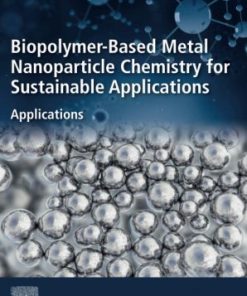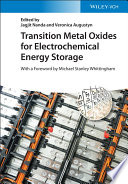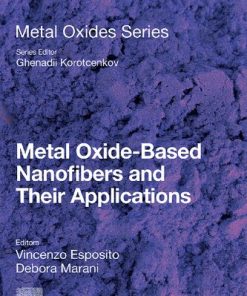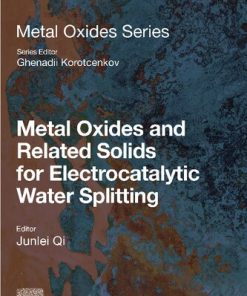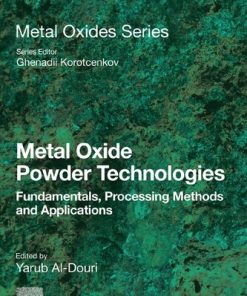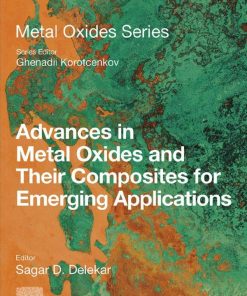(EBook PDF) Metal Oxides for Optoelectronics and Optics Based Medical Applications 1st edition by Suresh Sagadevan, Jiban Podder, Faruq Mohammad 0323858252 9780323858250 full chapters
$50.00 Original price was: $50.00.$25.00Current price is: $25.00.
Metal Oxides for Optoelectronics and Optics-Based Medical Applications 1st edition by Suresh Sagadevan, Jiban Podder, Faruq Mohammad – Ebook PDF Instant Download/DeliveryISBN: 0323858252, 9780323858250
Full download Metal Oxides for Optoelectronics and Optics-Based Medical Applications 1st edition after payment.
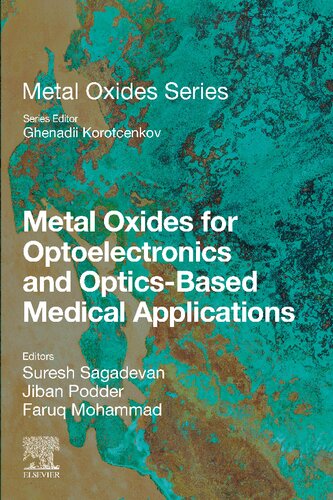
Product details:
ISBN-10 : 0323858252
ISBN-13 : 9780323858250
Author: Suresh Sagadevan, Jiban Podder, Faruq Mohammad
Metal Oxides for Optoelectronics and Optics-based Medical Applications reviews recent advances in metal oxides and their mechanisms for optoelectronic, photoluminescent and medical applications. In addition, the book examines the integration of key chemistry concepts with nanoelectronics that can improve performance in a diverse range of applications. Sections place a strong emphasis on synthesis processes that can improve the metal oxides’ physical properties and the reflected surface chemical changes that can impact their performance in various devices like light-emitting diodes, luminescence materials, solar cells, etc. Finally, the book discusses the challenges associated with the handling and maintenance of metal oxides crystalline properties.
Metal Oxides for Optoelectronics and Optics-Based Medical Applications 1st Table of contents:
Section A: Technology and properties
1: Metal oxides for optoelectronic and photonic applications: A general introduction
Abstract
1: Introduction
2: Properties of MOs
3: Chemical methods of MO synthesis
4: Physical methods of MO synthesis
5: Concluding remarks/conclusions
References
2: Recent developments in optoelectronic and photonic applications of metal oxides
Abstract
1: Introduction
2: Metal oxides (MOs) for various applications
3: Role of metal oxides for thin-film technology
4: Optoelectronic properties of metal oxides
5: Conclusion
References
3: Metal oxide-based glasses and their physical properties
Abstract
Acknowledgments
1: Introduction
2: Preparation of metal oxide glasses
3: Properties of metal oxide glasses
4: Future aspects and applications
5: Summary and conclusions
References
4: Metal oxide-based optical fibers (preparation, composition, composition-linked properties, physical parameters, and theoretical calculations)
Abstract
1: Introduction
2: Fabrication of optical fibers
3: Metal oxides in optical fibers formation
4: Applications of optical fiber
5: Conclusions
References
Section B: Optoelectronic and photonic applications
5: Metal oxide-based LED and LASER: Theoretical concepts, conventional devices, and LED based on quantum dots
Abstract
1: Introduction
2: Different metal oxide nanostructures for light-emitting diodes (LEDs) and UV detectors
3: Metal oxide-based LASER diodes
4: Quantum dots used for LEDs, LASERs, and conventional devices
5: Conclusions
6: Recommendations
References
6: Metal oxide-based photodetectors (from IR to UV)
Abstract
1: Introduction
2: Basic mechanism of metal oxide-based photodetection
3: Fundamental parameters of metal oxide-based photodetectors
4: Metal oxide-based photodetectors: Material selection, device design, and photosensing performances
5: Biomedical applications of metal oxide-based photodetectors
6: Conclusions and perspectives
References
7: Optical and optoelectronic metal oxide-based sensors; (optical sensors, principle, computational modeling, and application-based development)
Abstract
1: Introduction
2: Zinc oxide nanowires
3: Deposition by using RF sputtering
4: Optical properties of the ZnO nanowires
5: Gas sensing mechanism
6: Experiment procedure
7: Optical H2 gas sensing setup
8: Results and discussion
9: Conclusion
References
8: Passive optoelectronic elements
Abstract
1: Introduction to the fundamentals of passive optoelectronics
2: Relevant metal oxides for passive optoelectronics and their advantages
3: Conclusions
References
9: Metal oxide photonic crystals and their application (designing, properties, and applications)
Abstract
1: Introduction
2: Structure
3: Synthetic strategies for PCs
4: Application
5: Conclusion
References
10: Heavy metal oxide glasses and their optoelectronic applications (infrared transmission, luminescence, nonlinear optical susceptibilities, etc.)
Abstract
Acknowledgment
1: Introduction
2: Optical properties of rare-earth ion-doped bismuth- and lead-containing borate glasses
3: Optical properties and applications of lead (II) oxide (PbO) glasses
4: Conclusions
References
11: Integrated optoelectronics
Abstract
1: Introduction
2: Electrooptical phenomena
3: Integrated photonic devices
4: Waveguides including metal oxide glasses
5: Light modulators
6: Optical switches
7: Metal oxides designed for these applications
8: Manufacturing features
9: Conclusion
References
Section C: Metal oxide-based optoelectronic devices in biomedical applications
12: Metal oxide-based fiber technology in the pharmaceutical and medical chemistry
Abstract
Funding
Conflict of interest
1: Introduction
2: Electrospinning—Cutting edge technology
3: Feed materials for electrospinning
4: Applications of electrospun nanofibers in biomedical & environmental sector
5: Conclusion and future outlook
References
13: Metal oxide-involved photocatalytic technology in cosmetics and beauty products
Abstract
1: Introduction
2: Overview of MONPs and their applications
3: MONPs in cosmetics and beauty/personal care products
4: Photocatalytic activity of MONPs in sunscreen products
5: Conclusions and future perspectives
References
14: Illuminating metal oxides containing luminescent probes for personalized medicine
Abstract
1: Introduction
2: Zinc oxide materials
3: Titanium oxide materials
4: Other metal oxides
5: Conclusion
References
15: Metal oxide nanostructures and their biological applications (nonlinear photonics, plasmonic nanostructures, etc.)
Abstract
1: Introduction
2: Surface modification of metal oxide NPs: Biocompatibility and surface properties
3: Main types of metal oxide nanoparticles with potential use in biomedicine
4: Applications in biosystems
5: Applications based on thermal effects
6: Applications of MONPs in biomedicine
7: Nanotoxicology
8: Conclusions
People also search for Metal Oxides for Optoelectronics and Optics-Based Medical Applications 1st:
what is optical sciences
what are optical materials
what is optical science and engineering
state three materials used for making optical fibres
metal oxides for optoelectronic applications
Tags:
Metal Oxides,Optoelectronics,Optics Based,Medical Applications,Suresh Sagadevan,Jiban Podder,Faruq Mohammad
You may also like…
Technique - Nanotechnology
Engineering
Metal Oxide-Based Photocatalysis: Fundamentals and Prospects for Application 1ST EDITION
Chemistry - Technical & Industrial Chemistry
Biopolymer-Based Metal Nanoparticle Chemistry for Sustainable Applications Mahmoud Nasrollahzadeh
Technique - Materials
Advances in Metal Oxides and Their Composites for Emerging Applications Sagar D. Delekar






